When it comes to protecting yourself, you might wonder: are pepper spray and mace the same? It’s a common question because both are popular self-defense tools, but the truth is, they are quite different.
Knowing what sets them apart can make a big difference in how effectively you can defend yourself during a dangerous situation. If you want to choose the right protection for your safety, you need to understand how each works, what they contain, and which one delivers stronger, faster results.
Keep reading to discover the key differences between pepper spray and mace—so you can feel confident and ready to protect yourself when it matters most.

Credit: www.mace.com
Differences In Chemical Composition
The chemical makeup of pepper spray and mace sets them apart significantly. Each uses different active ingredients that affect the body in unique ways. These differences influence how they disable an attacker and how quickly they work. Understanding these distinctions helps in choosing the right self-defense tool.
Oleoresin Capsicum In Pepper Spray
Pepper spray contains oleoresin capsicum (OC), a natural oil from hot peppers. OC causes intense inflammation in the eyes, skin, and lungs. This leads to immediate burning, swelling, and temporary blindness. The effects quickly incapacitate an attacker, making escape easier. OC works even on people under the influence of drugs or alcohol.
Tear Gas In Traditional Mace
Traditional mace uses tear gas chemicals like CN or CS. These irritants cause pain and discomfort but do not inflame tissues. Tear gas can cause watery eyes, coughing, and irritation of the nose and throat. The effects are milder and may not stop a determined attacker. Tear gas is less effective on people who have a high pain tolerance or are intoxicated.
Modern Mace Formulations
Today’s Mace brand products often combine OC with tear gas. This mix aims to provide the quick inflammation of pepper spray plus the irritating effects of tear gas. Modern formulations improve the overall effectiveness and reliability. Users should check labels to see if the product contains OC for stronger protection.
How Pepper Spray Affects The Body
Pepper spray works by causing strong reactions in the body. It targets the eyes, skin, and lungs. This spray uses a substance called oleoresin capsicum (OC). OC comes from hot peppers and creates a burning feeling. This burning feeling stops attackers and gives you time to escape.
The effects start fast and are very intense. The body reacts to the spray with swelling and pain. This makes it hard for the attacker to see or breathe. It also causes coughing and choking, which helps disable the attacker quickly.
Inflammatory Mechanism
Oleoresin capsicum in pepper spray causes inflammation. It makes the eyes and skin swell and burn. The spray irritates the mucous membranes in the nose and throat. This leads to coughing and difficulty breathing. The inflammation is the body’s natural reaction to the irritant. It helps stop the attacker by causing extreme discomfort.
Physical Effects On Attackers
Attackers hit with pepper spray feel immediate pain. Their eyes close tightly and tear up. They may lose vision temporarily. The skin feels a burning sensation. Breathing becomes hard and fast. Coughing and choking follow. These effects make it very hard to continue an attack. The pain and discomfort force attackers to stop.
Effectiveness Against Intoxicated Individuals
Pepper spray works even if the attacker is drunk or high. Intoxicated people have a higher pain tolerance. Tear gas and other irritants may not stop them. OC in pepper spray causes inflammation that affects all. It bypasses pain tolerance by attacking the eyes and lungs. This makes pepper spray a reliable choice for self-defense in many situations.
How Traditional Mace Works
Traditional mace is a self-defense spray that relies on chemical irritants. It uses tear gas compounds to cause discomfort and pain. These chemicals irritate the eyes, nose, and throat. The goal is to deter an attacker by causing temporary discomfort.
Unlike pepper spray, traditional mace does not cause strong inflammation. Its effects are usually less intense and may take longer to affect an attacker. Understanding how traditional mace works helps explain its strengths and weaknesses.
Chemical Irritants Used
Traditional mace contains tear gas chemicals like CN or CS. These are different from the oleoresin capsicum found in pepper spray. CN and CS irritate mucous membranes and cause eye watering and coughing. The irritants create a burning sensation but do not inflame the skin strongly.
Impact On Pain Tolerance
The chemicals in traditional mace cause pain and discomfort. Some people may feel strong effects, while others may tolerate it better. Intoxicated or drug-impaired attackers often show less reaction. High pain tolerance can reduce mace’s effectiveness significantly.
Limitations In Incapacitating Attackers
Traditional mace may not stop every attacker quickly. Its effects are less immediate and less intense than pepper spray. Some attackers can keep moving despite the irritation. This limitation makes traditional mace less reliable for defense.

Credit: www.sabrered.com
Historical And Brand Confusion
The terms “Mace” and “pepper spray” often cause confusion. This confusion has roots in history and branding. Understanding this mix-up helps clarify what each product really is. The story begins with the brand name “Mace.”
Over time, the brand name became a common term. People started calling all sprays “Mace,” no matter the type. This caused many to mix up pepper spray and traditional mace. Both sprays serve self-defense but differ in chemicals and effects.
Mace As A Trademarked Brand
“Mace” started as a brand name for a specific spray product. The original Mace spray used tear gas compounds, not pepper spray. The brand built a strong reputation in personal safety. Its name became widely known and respected. This helped sales but also led to brand confusion.
Generic Use Of The Term Mace
People began using “Mace” to mean any self-defense spray. This includes pepper spray and tear gas sprays. The term lost its connection to the original brand. It became a generic name, like “Kleenex” for tissues. This common use makes it hard to know which spray is meant.
Impact On Consumer Understanding
Consumers often confuse pepper spray with traditional mace. They may buy the wrong product for their needs. Some expect tear gas effects but get pepper spray instead. Others want pepper spray but buy tear gas spray labeled as Mace. Clear knowledge about these products is important for safety.
Legal Considerations
Understanding the legal aspects of pepper spray and mace is crucial for anyone considering these tools for self-defense. Laws vary widely across states and cities, affecting possession and use. Being informed helps prevent legal troubles and ensures responsible use.
Legality Of Pepper Spray In The Us
Pepper spray is legal in most US states for self-defense. Some states require users to be above a certain age, usually 18. Restrictions may limit the size or concentration of the spray. Certain places, like schools and government buildings, often ban pepper spray. Always check local laws before buying or carrying pepper spray.
Legal Implications Of Using Pepper Spray
Using pepper spray must be for self-defense only. Misuse can lead to criminal charges, including assault. The spray should not be used to threaten or harm others unnecessarily. In some cases, using pepper spray on law enforcement can lead to serious penalties. Proper understanding of when and how to use it is essential.
Regulations Surrounding Mace
Mace, like pepper spray, has legal restrictions in many areas. Its chemical makeup may classify it differently under the law. Some states treat mace as a more controlled substance due to tear gas content. Carrying mace in restricted areas can result in fines or confiscation. Always verify specific regulations before possession or use.

Credit: www.srselfdefense.com
Choosing Between Pepper Spray And Mace
Choosing between pepper spray and mace is important for personal safety. Both offer protection but differ in how they work and when to use them. Understanding these differences helps pick the right option for self-defense. This section breaks down key points to consider.
Factors Affecting Effectiveness
Pepper spray causes strong inflammation and pain. It works quickly on eyes, skin, and lungs. This stops attackers fast, even if they are drunk or on drugs. Mace uses tear gas, which irritates but may not stop tough attackers. Weather and wind can change how well either spray works. Always check product strength and expiration date.
Situations Best Suited For Each
Pepper spray suits close encounters and sudden attacks. It is good for all types of threats. Mace works better in open spaces and less serious threats. It may not stop violent attackers quickly. Consider the environment and how much space is around before choosing. Carry what fits your lifestyle and local laws.
Recommendations For Self-defense
Choose pepper spray for strong, fast defense. It offers reliable protection in most cases. Keep spray easy to reach and practice using it. Always stay aware of surroundings. Use mace if you want lighter protection or are in crowded places. Training with your chosen spray improves confidence and safety.
Frequently Asked Questions
Which Is Stronger, Pepper Spray Or Mace?
Pepper spray is stronger than traditional mace. It contains oleoresin capsicum (OC), causing intense inflammation and quick incapacitation. Mace uses tear gas, which is less effective, especially on intoxicated attackers. For reliable self-defense, OC-based pepper spray is the preferred choice.
Is Mace Spray Legal In The Us?
Mace spray legality varies by state in the US. Many states allow it with restrictions on size and concentration. Always check local laws before purchase or use.
Why Is Pepper Spray Called Mace?
Pepper spray is called mace because the original brand “Mace” produced tear gas-based sprays. Today, “mace” often refers to pepper spray too.
Is Mase The Same As Pepper Spray?
Mace and pepper spray differ. Traditional mace uses tear gas, while pepper spray contains oleoresin capsicum (OC), causing stronger effects. Modern Mace products may include OC, but pepper spray generally offers more reliable self-defense by causing intense inflammation and incapacitation.
Conclusion
Pepper spray and mace are not exactly the same. Pepper spray uses oleoresin capsicum (OC) to cause strong inflammation. This makes attackers lose vision and breath temporarily. Mace usually contains tear gas, which irritates but may be less effective. Many modern products mix both ingredients for better defense.
Choosing pepper spray with OC ensures faster and stronger effects. Understanding these differences helps you pick the right self-defense tool. Stay informed and stay safe.







